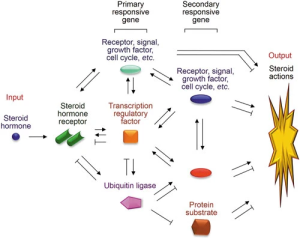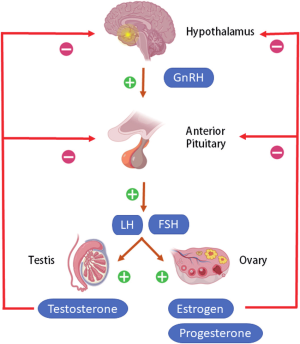Unusualcrow (talk | contribs) (Created page with "= Medical Transition Pages = Pages pertaining to medical transition resources.") |
No edit summary |
||
| (10 intermediate revisions by 4 users not shown) | |||
| Line 1: | Line 1: | ||
= Medical Transition Pages = | = Medical Transition Pages = | ||
All people have both estrogen and testosterone (as well as other sex hormones) naturally occurring in their body and it is the levels of those hormones which cause the difference we see between male and female development. The blueprint for development is encoded on the autosomal (non-sex) chromosomes and parts of it are activated or deactivated based on the effects of hormones. Transitioning with the use of hormone replacement therapy (HRT) acts on the tissues in your body and transforms your phenotype<ref>https://www.ncbi.nlm.nih.gov/pmc/articles/PMC6533072/</ref>: Sex hormones bind to sex hormone receptors in various cells and then translocate into the cell nucleus. In the nucleus, a ligand-bound sex hormone receptor acts a transcription factor by binding to the promoter region of genes containing a hormone responsive element (HRE), leading to regulation of gene expression.<ref>[https://pubmed.ncbi.nlm.nih.gov/16273365/#:~:text=Nuclear%20sex%20hormone%20receptors%20are,the%20expression%20of%20target%20genes. https://pubmed.ncbi.nlm.nih.gov/16273365/#:~:text=Nuclear%20sex%20hormone%20receptors%20are,the%20expression%20of%20target%20genes.]</ref> | |||
[[File:Transcriptional network of steroid hormone receptors.png|center|thumb|[https://www.nature.com/articles/aps2014123 Transcriptional network of hormone receptors]]] | |||
The human body regulates levels of sex hormones using hypothalamic-pituitary-gonadal axis (HPG axis is the endo term used). The axis controls development, reproduction, and aging in animals. Gonadotropin-releasing hormone (GnRH) is secreted from the hypothalamus by GnRH-expressing neurons. The anterior portion of the pituitary gland produces luteinizing hormone (LH) and follicle-stimulating hormone (FSH), and the gonads produce estrogen and testosterone. | |||
[[File:HPG axis.png|center|thumb|[https://www.intechopen.com/chapters/75387 HPG Axis]]] | |||
Modern HRT utilizes "bioidentical" medication which means it has the same chemical structure as the endogenous hormones which your body naturally produces. Physiological data and clinical outcomes demonstrate that bioidentical hormones are associated with lower risks, including the risk of breast cancer and cardiovascular disease, and are more efficacious than their synthetic and animal-derived counterparts.<ref>https://www.tandfonline.com/doi/abs/10.3810/pgm.2009.01.1949</ref> | |||
=== Medical Guidelines === | |||
'''The Journal of Clinical Endocrinology & Metabolism:''' [https://academic.oup.com/jcem/article/102/11/3869/4157558 Endocrine Treatment of Gender-Dysphoric/Gender-Incongruent Persons: An Endocrine Society Clinical Practice Guideline.] | |||
'''World Professional Association for Transgender Health:''' [https://www.tandfonline.com/doi/pdf/10.1080/26895269.2022.2100644 Standards of Care for the Health of Transgender and Gender Diverse People, Version 8] | |||
Please note that the WPATH is a standard used by many healthcare providers including public health services and health insurance companies with policies for covered trans treatments. As of September 2022 the release of SOC 8 includes the following: AMAB: facial feminization surgery (including chondrolaryngoplasty/vocal cord surgery), gender-affirming breast surgery, body contouring procedures, orchiectomy, vagino/vulvoplasty (with/without depth), aesthetic procedures, and procedures designed to prepare individuals for surgery (i.e., hair removal). | |||
For other detailed information, this is currently the best source on transfem hormone therapy: https://transfemscience.org/articles/transfem-intro/ | |||
Latest revision as of 02:49, 18 March 2024
Medical Transition Pages
All people have both estrogen and testosterone (as well as other sex hormones) naturally occurring in their body and it is the levels of those hormones which cause the difference we see between male and female development. The blueprint for development is encoded on the autosomal (non-sex) chromosomes and parts of it are activated or deactivated based on the effects of hormones. Transitioning with the use of hormone replacement therapy (HRT) acts on the tissues in your body and transforms your phenotype[1]: Sex hormones bind to sex hormone receptors in various cells and then translocate into the cell nucleus. In the nucleus, a ligand-bound sex hormone receptor acts a transcription factor by binding to the promoter region of genes containing a hormone responsive element (HRE), leading to regulation of gene expression.[2]

The human body regulates levels of sex hormones using hypothalamic-pituitary-gonadal axis (HPG axis is the endo term used). The axis controls development, reproduction, and aging in animals. Gonadotropin-releasing hormone (GnRH) is secreted from the hypothalamus by GnRH-expressing neurons. The anterior portion of the pituitary gland produces luteinizing hormone (LH) and follicle-stimulating hormone (FSH), and the gonads produce estrogen and testosterone.

Modern HRT utilizes "bioidentical" medication which means it has the same chemical structure as the endogenous hormones which your body naturally produces. Physiological data and clinical outcomes demonstrate that bioidentical hormones are associated with lower risks, including the risk of breast cancer and cardiovascular disease, and are more efficacious than their synthetic and animal-derived counterparts.[3]
Medical Guidelines
The Journal of Clinical Endocrinology & Metabolism: Endocrine Treatment of Gender-Dysphoric/Gender-Incongruent Persons: An Endocrine Society Clinical Practice Guideline.
World Professional Association for Transgender Health: Standards of Care for the Health of Transgender and Gender Diverse People, Version 8
Please note that the WPATH is a standard used by many healthcare providers including public health services and health insurance companies with policies for covered trans treatments. As of September 2022 the release of SOC 8 includes the following: AMAB: facial feminization surgery (including chondrolaryngoplasty/vocal cord surgery), gender-affirming breast surgery, body contouring procedures, orchiectomy, vagino/vulvoplasty (with/without depth), aesthetic procedures, and procedures designed to prepare individuals for surgery (i.e., hair removal).
For other detailed information, this is currently the best source on transfem hormone therapy: https://transfemscience.org/articles/transfem-intro/
Subcategories
This category has the following 2 subcategories, out of 2 total.
B
- Breast Growth (2 P)
P
- Procedures (4 P)
Pages in category "Medical"
The following 5 pages are in this category, out of 5 total.